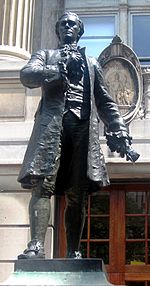Contents
Hamilton Hall is an academic building on the Morningside Heights campus of Columbia University on College Walk (West 116th Street) at 1130 Amsterdam Avenue in Manhattan, New York City, serving as the home of Columbia College. It was built in 1905–1907 and was designed by McKim, Mead & White in the Neoclassical style; the building was part of the firm's original master plan for the campus. The building was the gift of the John Stewart Kennedy, a former trustee of Columbia College,[1] and is named after Alexander Hamilton, who attended King's College, Columbia's original name. A statue of Hamilton by William Ordway Partridge stands outside the building entrance. Hamilton Hall is the location of the Columbia College administrative offices.[2]
History


The original Hamilton Hall was built in 1878 in the Gothic Revival style and located on Madison Avenue between 49th and 50th streets on the college's former Midtown campus. It was five stories tall and had an elaborate turret at its northwest corner.[3] It was located directly across 50th Street from the Villard Houses and was demolished in 1896.[4]
When Columbia became a university and relocated to Morningside Heights in the 1890s, there were originally no plans for the area south of 116th Street, where Hamilton Hall now sits, or for any facilities dedicated to the undergraduate college. Nevertheless, college advocates persevered and the cornerstone for the new Hamilton Hall was laid in 1905. The building was designed by the firm of McKim, Mead, and White in the neoclassical style, in conformity with the rest of the university campus.[5][6] It was completed in 1907.[7]
Hamilton Hall has undergone extensive renovations in order to restore many of its historic details. Two stained glass windows depicting Sophocles and Virgil, gifts from the class of 1885 and 1891, respectively, were installed in the Hamilton Hall lobby in 2003, having sat in storage for nearly 60 years.[8] The building houses many of the classes of Columbia College's Core Curriculum.
Protests
Starting in the latter half of the 20th century, Hamilton Hall was taken over several times in the course of student activism at Columbia University, most famously during the protests of April 1968. In the course of this protest, a multiracial group first barricaded themselves inside the building, imprisoning acting dean Henry S. Coleman in his office. The black students renamed the building "Malcolm X Liberation College" and eventually asked the white students to leave,[9] prompting the latter's takeover of several other university buildings. After the violent end to the April activities, Hamilton was the most peacefully cleared hall but was briefly reoccupied later that year.
The building was then the site of a major 1985 student strike and barricade to demand university divestment from South Africa, which was under the apartheid system at the time, as well as ethnic studies classes at the university. During the 1985 strike, the building was renamed "Mandela Hall" by the occupying students.[10][11]
In 2024, a group of student activists who had been participating in a tent encampment protesting the Israeli invasion of the Gaza Strip occupied the hall.[12][13] During the occupation of the hall, protesters unfurled a large banner and renamed the hall "Hind's Hall" in reference to Hind Rajab, a young Palestinian girl killed in the ongoing Israel–Hamas War.[13][14] The hall was forcibly cleared by the New York Police Department on the evening of April 30, 2024.[15]
References
- ^ Roberts, Elliot (October 19, 1955). "1955 Marks Fiftieth Anniversary of Cornerstone of Hamilton Hall". Columbia Daily Spectator. Retrieved April 20, 2016.
- ^ "Hamilton". Columbia University Facilities. Archived from the original on February 19, 2016. Retrieved January 17, 2015.
- ^ Columbia university. [from old catalog] (1886). Views of Columbia college ... New York. The Library of Congress. Boston, Pub. by Library bureau. Retrieved October 9, 2023.
- ^ Shekitka, John P. (July 31, 2023), The 'Lost' Columbia College Midtown Campus: 1857–1896: A Visual History. Guest Lecture for S3535: History of the City of New York. Department of History, Columbia University.
- ^ "To Be Hamilton Hall". The New York Times. May 2, 1905. Retrieved May 2, 2024.
- ^ "Begin Hamilton Hall". New-York Tribune. September 27, 1905. Retrieved May 2, 2024 – via Newspapers.com.
- ^ "Hamilton Hall Opened to Columbia Students". The New York Times. February 3, 1907. Retrieved May 2, 2024.
- ^ "Before Morningside Heights: Columbia's Second Home – News from Columbia's Rare Book & Manuscript Library". blogs.cul.columbia.edu. May 11, 2022. Retrieved June 25, 2022.
- ^ "Columbia University Libraries Online Exhibitions | 1968: Columbia in Crisis". exhibitions.library.columbia.edu. Retrieved May 2, 2024.
- ^ "'Hind Hall': How Columbia's Hamilton Hall became its signature protest hub". Al Jazeera. May 1, 2024. Retrieved May 2, 2024.
- ^ Lee, Johanna (April 13, 2016). "Mandela Hall: A History of the 1985 Divest Protests". Columbia Daily Spectator. Retrieved May 2, 2024.
- ^ McKee, Amira; Huddleston, Sarah; Karam, Esha; Vance, Shea; Silva, Manuela; Clearly, Claire (April 30, 2024). "Dozens occupy Hamilton Hall as pro-Palestinian protests spread across campus". Columbia Daily Spectator. Retrieved April 30, 2024.
- ^ a b Watkins, Ali (April 30, 2024). "Columbia Protesters Rename Hamilton Hall to 'Hind's Hall'". The New York Times. Archived from the original on May 1, 2024. Retrieved April 30, 2024.
- ^ Graziosi, Graig (May 1, 2024). "Why have Columbia students renamed the college hall they occupied Hinds Hall?". The Independent. Archived from the original on May 1, 2024. Retrieved May 2, 2024.
- ^ Karam, Esha; Vance, Shea; Huddleston, Sarah; McKee, Amira; Silva, Manuela (April 30, 2024). "NYPD sweeps occupied Hamilton Hall, arrests dozens". Columbia Daily Spectator. Retrieved April 30, 2024.

